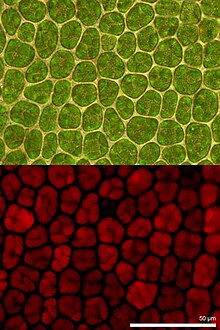


Chlorophyll fluorescence is light re-emitted by chlorophyll molecules during return from excited to non-excited states. It is used as an indicator of photosynthetic energy conversion in plants, algae and bacteria. Excited chlorophyll dissipates the absorbed light energy by driving photosynthesis (photochemical energy conversion), as heat in non-photochemical quenching or by emission as fluorescence radiation. As these processes are complementary processes, the analysis of chlorophyll fluorescence is an important tool in plant research with a wide spectrum of applications.[1][2]
- ^ Lu, Congming; Zhang, Jianhua (July 1999). "Effects of Water Stress on Photosystem II Photochemistry and Its Thermostability in Wheat Plants" (PDF). Journal of Experimental Botany. 50 (336): 1199–1206. doi:10.1093/jxb/50.336.1199.
- ^ Lembrechts, JJ; Zinnert, JC; Mänd, P; De Boeck, HJ. "5.1 Chlorophyll fluorescence". ClimEx Handbook. Retrieved 2020-01-14.